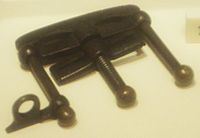Thumbscrew (torture)




The thumbscrew is a
Other terminology
The thumbscrew was also referred to as thumbkin or thumbikin (1675–1685), "kin" being a diminutive suffix of nouns.[2] An alternate spelling was thumbikens.[3] The terms pillywinks and pilnie-winks[4] were also in use.
Historians James Cochrane and John McCrone wrote in 1833,
Thus we read, that in 1596, the son and daughter of Aleson Balfour, who was accused of witchcraft were tortured before her to make her confess her crime in the manner following: Her son was put in the buits where he suffered fifty seven strokes; and her daughter about seven years old, was put in the pilniewinks. In the same case, mention was made, besides pilniewinks, pinniewinks or pilliwinks, of caspitanos or caspicaws, and of tosots, as instruments of torture. Lord Royston in his manuscript notes upon Mackenzie's criminal law conjectures that these may have been only other names for the buits and thumbikens; thus much seems certain, that in those times there was some torturing device applied to the fingers which bore the name of pilniewinks; but it will immediately appear, that the most authentic accounts assign the introduction and use of the instrument known by the name of thumbikens to a much later period.[3]
History
Cochrane and McCrone argue that the thumbscrew entered Britain later than the invasion of the Spanish Armada in the 16th century:
"It has been very generally asserted," says Dr. Jamieson, "that part of the cargo of the invincible Armada was a large assortment of thumbikens, which it was meant should be employed as powerful arguments for convincing the heretics." The country of the inquisition was certainly a fit quarter from whence to derive so congenial an instrument; but other accounts, as we have said, and these apparently unquestionable, assign it a later introduction... In the torturing of [William] Spence,
privy council in 1684, quoted in Wodrow's invaluable history: "Whereas there is now a new invention and engine called the thumbikens ... the Lords of His Majesty's Council do therefore ordain, that when any person shall be put to the torture, that the boots and the thumbikens both be applied to them..."[3]
In 1612 the Baroque painter, Orazio Gentileschi, accused his colleague, Agotino Tassi, of raping his daughter, the painter Artemisia Gentileschi. During the five-month long trial, Artemisia was cross-examined under thumb-screw torture.[5][6]
As late as the mid-18th century, the ex-slave
References
- ^ Held, Robert. Inquisition: A Bilingual Guide to the Exhibition of Torture Instruments from the Middle Ages to the Industrial Era, Florence: Qua d'Arno, 1985.
- ^ "Thumbkin". Dictionary.com. 2015. Retrieved June 2, 2015.
- ^ a b c Cochrane, James; McCrone, John (1833). The Waverley Anecdotes: Illustrative of the Incidents, Characters, and Scenery, Described in the Novels and Romances, of Sir Walter Scott, Bart. Vol. 1. London; Boston: J. Cohrane and J. McCrone. pp. 46–50.
The Thumbikens, as the name imports, was an instrument applied to the thumbs, in such a manner as to enable the executioner to squeeze them violently; and this was often done with so much force as to bruise the thumb-bones, and swell the arms of the sufferer up to his shoulders.
- ISBN 9780750957953.
- ISBN 978-0-7892-0768-5.
- ISBN 978-0-500-20456-6.
- ^ Equiano, Olaudah (1789). The Interesting Narrative of the Life of Olaudah Equiano, Or Gustavus Vassa, The African.
The iron muzzle, thumb-screws, &c. are so well known, as not to need a description, and were sometimes applied for the slightest faults.
- ^ Hochschild, Adam. Bury the Chains: The British Struggle to Abolish Slavery (Basingstoke: Pan Macmillan, 2005)
- ISBN 9781460402054. Retrieved August 11, 2014.
External links
 Media related to Thumbscrews (torture) at Wikimedia Commons
Media related to Thumbscrews (torture) at Wikimedia Commons
